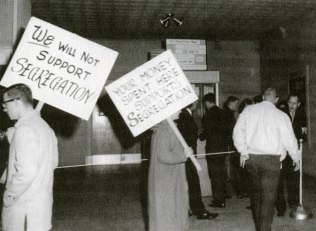Texas Theater Integration
Introduction
Text-to-speech Audio
Images
UT students continue their protest against segregation at the drag theater. Source: Nicar, Jim. "How UT Students – and Eleanor Roosevelt – Integrated the Drag." UT History Corner.

The once popular and controversial Texas Theater is now the present day site of CVS. Source: Joshua Balli

Backstory and Context
Text-to-speech Audio
Many University of Texas students took aim at the theaters “Whites Only” policy in hopes of banning the racist rule and integrating the theater. As students from all backgrounds united behind the cause of integration, the Students for Direct Action (SDA) was conceived and this group became the leading organization in the resistance of segregation. UT Student Chandler Davidson would later state in an interview that this organization was a necessity due to integration efforts in the University area being nonexistent. Additionally, SDA would attempt to illuminate many of the problems African American and other minority groups would face and how and how to “take peaceful, lawful, but definite action to remedy the situation.”[1] As the SDA became more popular one of the main priorities was the integration of businesses on the drag. As plans to protest the theater were being made, African American student Houston Wade put forth the idea of using a combination of sit ins and standing protests he called a stand-in. SDA adopted the proposal and put the idea into practice. With the intention of ending segregation, over one hundred UT students crossed Guadalupe Street to the Texas Theater and lined up in front of the box office appearing to be buying tickets. One by one, the students would approach the box office window and recite “I would like to buy a ticket if everybody is being admitted,” the students said. Ticket sellers denied the request repeatedly, and the group of African-American and white students would return to the end of the line only to try again.[2] Though unsuccessful, the students were not daunted and returned the next day repeating the same mantra and undergoing the same process. In addition to the growing amount of support from fellow Longhorns, many UT faculty openly supported the student’s nondiscriminatory efforts “with 192 faculty members publicly endorsing the stand-ins within its first month.”[3]
In addition to the growing support from University faculty and students, the University Baptist Church, located on the same street as the Texas Theater, endorsed the protests and displayed support for the students. The pastor, Dr. Blake Smith, issued a statement to the Daily Texan stating that “Racial segregation is a betrayal of democracy, an affront to human dignity and an insult to God”.[4] As the protesters multiplied in numbers, theater manager Leonard Masters moved the box office indoors and attempted to hinder and dissuade protest of his theater stating “I’m not going to have arguments going on in my theater” and later defending his theater's racist policy by arguing that “We have a policy and I have to enforce it. My feelings have nothing to do with it.”[5]
Despite growing support for integration, many UT students and drag business owners frowned upon the students intervention and deliberate rebellion against the status quo. Though their attempted efforts seemed futile, the students were steadfast in their resolve and belief. The students continued their protest against the policy despite their formidable odds of achieving any real progress. Through the opposition, the student protesters received a jolt of momentum when former First Lady Eleanor Roosevelt flung her support behind the students. Additionally, Roosevelt wrote about the events in her columnn entitled “My Day” elevating these events from the local and state level to the national spot light. “I am personally grateful to the Texas students for making the effort to bring about the end of this kind of segregation” Roosevelt wrote.[6]
In an attempt to appease protesters and with mounting pressure growing on the theater to integrate, Leonard Masters agreed to a one-month trial period of allowing white and African American students purchase tickets. At the expiration of the one month trial, the Texas Theater annulled the previous policy of segregation and the theater allowed all people regardless of race.
Through growing adversity the UT student protesters were able to persevere in their fight against institutional racism. These events are important because it set a precedent of integration and engendered a domino effect of integration throughout Austin.
Sources
[2] Cardenas, Cat. "TBT: Students Protest to Integrate Drag Theater in 1960." The Daily Texan. Texas Student Media, 2015
[3] -Buckely, Jordan. "The Desegregation of Austin's Movie Theatres." The Austin Chronicle. Louis Black, 2015.
[4] David Slider. “Signs Carried. Pickets used for first time” The Daily Texan, Texas Student Media, 1961.
[5] Cardenas, Cat. “TBT: Student Protest to Integrate Drag Theater in 1960.” The Daily Texas, Texas Student Media, 2015.
[6] Roosevelt, Eleanor, My Day by Eleanor Roosevelt, 1960.
